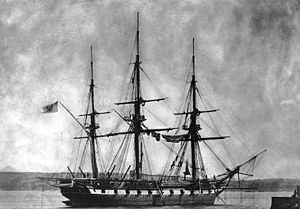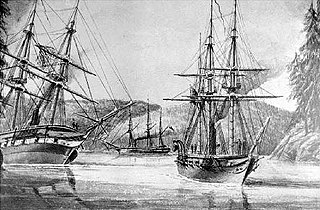
HMS Plumper was part of the 1847 programme, she was ordered on the 25 of April as a steam schooner from Woolwich Dockyard with the name Pincher. However, the reference Ships of the Royal Navy, by J.J. College, (c) 2020 there is no entry that associates this name to this build. The vessel was reordered on August 12 as an 8-gun sloop as designed by John Fincham, Master Shipwright at Portsmouth. Launched in 1848, she served three commissions, firstly on the West Indies and North American Station, then on the West Africa Station and finally in the Pacific Station. It was during her last commission as a survey ship that she left her most enduring legacy; in charting the west coast of British Columbia she left her name and those of her ship's company scattered across the charts of the region. She paid off for the last time in 1861 and was finally sold for breaking up in 1865.
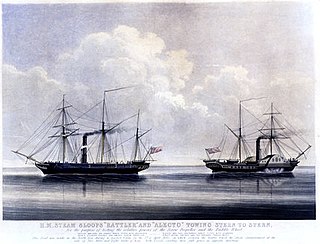
HMS Rattler was a 9-gun steam screw sloop of the Royal Navy, and one of the first British warships to be completed with screw propulsion. She was originally ordered as a paddle wheel 4-gun steam vessel from Sheerness Dockyard on 12 March 1841. She was reordered on 24 February 1842 as a propeller type 9-gun sloop from HM Royal Dockyard, Sheerness, as a new vessel. William Symonds had redesigned the ship as a screw propeller driven vessel.
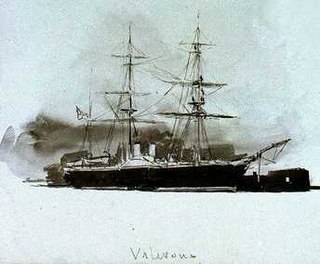
HMS Valorous was one of two 16-gun, steam-powered Magicienne-class second-class paddle frigates built for the Royal Navy in the 1850s. Commissioned in 1853 she played a small role in the Crimean War of 1854–1855 and was sold for scrap in 1891.
HMS Anne was a 70-gun third rate ship of the line of the English, built under the 1677 Construction Programme by Phineas Pett II at Chatham Dockyard during 1677/78. She fought in the War of English Succession 1688 to 1697. She fought in the Battle of Beachy Head where she was severely damaged and ran aground. She was burnt by the English to avoid capture by the French. The wreck is a Protected Wreck managed by Historic England.
HMS Exeter was a 70-gun third rate ship of the line of the Kingdom of England, built by contract Sir Henry Johnson at Blackwall under the 1677 Construction Programme. She was at the Battle of Beachy Head in 1690. She was accidentally burnt at Plymouth in 1691. Her remains were hulked at Portsmouth until she was broken in 1717.

HMS Niger was originally slated to be built as a Sampson designed sloop; however, she was ordered as a First-Class sloop with screw propulsion on 20 February 1845 to be built at Woolwich Dockyard, along the design developed by Oliver Lang and with a hull like the Basilisk designed paddle sloops. Her armament and engine were to be like the Encounter Design building at Pembroke. A second vessel (Florentia) was ordered on 26 March 1846 but after her keel was laid at Pembroke Dockyard, her construction was suspended on 6 October 1846 then cancelled three years later, on 22 May 1849. Niger She conducted important propulsion trials, finally proving the superiority of screw propulsion and served in West Africa, the Crimea, China, the East Indies and Australia. She took part in the New Zealand wars in 1860 and was sold for breaking in 1869.

HMS Salamander was one of the initial steam powered vessels built for the Royal Navy. On 10 January 1831 the First Sea Lord gave orders that four paddle vessels be built to competitive designs. The vessels were to be powered by Maudslay, Son & Field steam engines, carry a schooner rig and mount one or two 10-inch shell guns. Initially classed simply as a steam vessel (SV), she was re-classed as a second-class steam sloop when that categorization was introduced on 31 May 1844. Designed by Joseph Seaton, the Master Shipwright of Sheerness, she was initially slated to be built in Portsmouth, and was changed to Sheerness Dockyard. She was launched and completed in 1832, took part in the Second Anglo-Burmese War and was broken up in 1883.

HMS Jackal was a Jackal-class second-class iron paddle gunvessel of the Royal Navy.
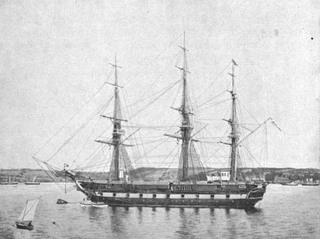
SMS Niobe was a Diamond-class 28-gun sixth-rate sailing frigate built for the Royal Navy in the 1840s. She was never commissioned into the Royal Navy, which was converting to steam power, and was sold to Prussia in 1862. She was named after Niobe, a figure from Greek mythology. She served with the Prussian Navy, the North German Federal Navy and the Imperial German Navy as a training ship until stricken and hulked in 1890. Niobe was eventually broken up in 1919.

HMS Magicienne was the lead ship of her class of two 16-gun, steam-powered second-class paddle frigates built for the Royal Navy in the 1850s. Commissioned in 1853 she played a small role in the Crimean War of 1854–1855 and was sold for scrap in 1866.

HMS Encounter was ordered as a First-Class Sloop with screw propulsion on 5 February 1845 to be built at Pembroke, in accordance with the design developed by John Fincham, Master Shipwright at Portsmouth. Her armament was to consist of 8 guns. She was to have a more powerful steam engine rated at 360 nominal horsepower. In 1848 she would be altered abaft and lengthened at Deptford prior to completion. A second vessel (Harrier) was ordered on 26 March 1846 but after her keel was laid at Pembroke Dockyard, her construction was suspended on 9 September 1846 then cancelled five years later, on 4 April 1851. Encounter had her armament radically altered in 1850 and she was broken up at Devonport in 1866.

HMS Reynard was part of the 1847 Program, she was ordered on 25 April as a steam schooner from Deptford Dockyard with the name ‘Plumper’. However, the reference Ships of the Royal Navy, by J.J. College, © 2020, there is no entry that associates the name Plumper to this build. The vessel was reordered on 12 August as an 8-gun sloop as designed by John Edye. She was launched in 1848, conducted anti-piracy work in Chinese waters and was wrecked near Pratas Island in the South China Sea on 31 May 1851.

On 26 March 1846, two vessels were ordered from Deptford Dockyard as Rifleman-designed gunvessels named Archer and Parthian. However, on 9 September 1846 the orders for both vessels were suspended prior to the vessels being laid down. On 25 April 1847 two vessels were ordered to the improved Rattler-type screw sloops as designed by John Edye of the Surveyor's Department from Deptford Dockyard. The first vessel, Archer may have been the change of the build from the Rifleman type to the sloop design. The second vessel, Wasp, appears to be a new vessel as the build for the Parthian remained on the books at Deptford until June 1849, when it was cancelled. Archer received the machinery from the gunvessel Rifleman, which resulted in an increase of speed over Wasp. Wasp's hull was sheathed in Muntz metal to retard marine growth. Their armament would increase from 12 to 15 guns over their careers. Both vessels would participate in the Russian War of 1854–1855. Both would be broken by 1869.
HMCS Bayfield was a Bangor-class minesweeper initially constructed for the Royal Navy during the Second World War. Transferred to the Royal Canadian Navy in 1942, the minesweeper saw service on both the West and East Coasts of Canada as a convoy escort and patrol vessel. In 1944, Bayfield sailed for European waters and took part in the invasion of Normandy. She remained in European waters for the rest of the war and was returned to the United Kingdom in September 1945. The minesweeper was laid up until being discarded for scrap in 1948.
HMCS Canso was a Bangor-class minesweeper initially constructed for the Royal Navy during the Second World War. Transferred to the Royal Canadian Navy in 1942, the minesweeper saw service on both the West and East Coasts of Canada as a convoy escort and patrol vessel. The vessel participated in the invasion of Normandy and spent the final years of the war in European waters. Canso was returned to the Royal Navy following the war and was broken up for scrap in 1948.

SMS Victoria was the second and final member of the Augusta class of steam corvettes built for the Prussian Navy in the 1860s. She had one sister ship, Augusta; the ships were armed with a battery of fourteen guns. Victoria was laid down in 1863 at the Arman Brothers shipyard in Bordeaux, France, and was launched in early 1864. Originally ordered by the Confederate States Navy, her delivery was blocked by the French Emperor Napoleon III, and she was instead sold to the Prussian Navy in May 1864. The Prussians had been in search of vessels to strengthen their fleet before and during the Second Schleswig War against Denmark, but Victoria arrived too late to see action in the conflict.

SMS Preussischer Adler was a paddle steamer originally built in the mid-1840s for use on a packet route between the Kingdom of Prussia and the Russian Empire in the Baltic Sea. She was requisitioned by the Prussian Navy during the First Schleswig War in 1848 and converted into an aviso, the first vessel of the type commissioned by Prussia. During the war, she took part in an inconclusive action with the Danish brig St. Croix, the first naval battle of the Prussian fleet. After the war, she was disarmed and returned to her commercial role, operating uneventfully on the Stettin–St. Petersburg route until 1862, when the expansion of the Prussian Eastern Railway had rendered the maritime route superfluous. The ship was purchased by the Prussian Navy that year and rearmed, once again as an aviso.

SMS Nix was the lead ship of the two-vessel Nix class of avisos built for the Prussian Navy in the early 1850s. After commissioning in 1851, Nix saw little activity, apart from short training exercises and cruises in the Baltic Sea, which were frequently punctuated with boiler fires. A dissatisfied Prussian Navy decided to sell both Nix-class ships. In 1855, the Prussians sold Nix to the British Royal Navy in exchange for the sail frigate Thetis, and was commissioned as HMS Weser. She saw action during the Crimean War at the Battle of Kinburn in October 1855, and thereafter saw little activity, being based in Malta. She was ultimately decommissioned in 1865, used as a harbor ship, and then sold to ship breakers in 1873.

The Nix class was a pair of avisos built for the Prussian Navy in the early 1850s. The class comprised two ships: SMS Nix and Salamander. They were ordered as part of a modest program to strengthen the fleet at the urging of Prince Adalbert of Prussia in the immediate aftermath of the First Schleswig War, which had demonstrated that the weak fleet could not challenge the ability of Denmark to impose a blockade of Prussian and German ports. They were small vessels with a shallow draft, since they were intended to operate close to shore to defend Prussia's coast. Neither vessel saw significant service in the Prussian Navy before being sold to the British Royal Navy in exchange for the frigate Thetis in 1855. They were renamed Weser and Recruit, respectively, and the former saw action during the Crimean War in the Black Sea later in 1855. The two ships saw little activity after their sale to Britain, with Recruit being laid up in 1861 and Weser following in 1865. Recruit was sold for merchant service in 1870, while Weser was discarded in 1873.
HMS Rhadamanthus was one of the initial steam powered vessels built for the Royal Navy. On 10 January 1831 the First Sea Lord gave orders that four paddle vessels be built to competitive designs. The vessels were to be powered by Maudslay, Son & Field steam engines, carry a schooner rig and mount one or two 10-inch shell guns. Initially classed simply as a steam vessel (SV), she was re-classed as a second-class steam sloop in 1846. Designed by Thomas Roberts, the Master Shipwright of Plymouth. She was launched and completed in 1832, She was converted into a transport in 1841 then in 1851 she was a troopship and by the 1860s she was a transport again. Her breaking was completed in February 1864.
